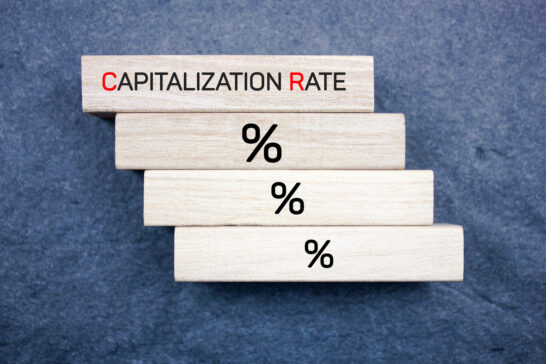 In real estate, understanding the critical concepts behind multifamily cap rates can give investors the knowledge needed to make informed decisions. For those asking, “What is a good cap rate for multifamily?” — understanding this financial metric is the first step in preparing to enter the world of property investment.
In real estate, understanding the critical concepts behind multifamily cap rates can give investors the knowledge needed to make informed decisions. For those asking, “What is a good cap rate for multifamily?” — understanding this financial metric is the first step in preparing to enter the world of property investment.
Cap rates, or capitalization rates, are crucial indicators of potential return on investment (ROI) and help assess a property’s risk and profit potential. At Vistia Capital, our goal is to empower investors by demystifying the concepts behind cap rates, including why investments with a higher cap rate may carry more risk and how they compare to ROI vs. cap rate analyses.
Whether you’re curious about current cap rates for multifamily properties or pondering “Is a higher or lower cap rate better?” continue reading as we explore what you need to know to navigate multifamily real estate investments with confidence.
What Are Capitalization Rates?
Capitalization rates, or cap rates, are a foundational metric used in real estate investing, especially within the multifamily sector. A cap rate measures the potential rate of return on a real estate investment property, offering an overview of its risk and profitability potential. Cap rates are calculated by dividing the Net Operating Income (NOI) the property generates annually by its current market value or purchase price.
Understanding multifamily cap rates is essential for investors who want to understand how multifamily properties are performing financially. A cap rate offers a quick, comparative tool to evaluate different real estate investments, making it easier to pinpoint opportunities that align with an investor’s financial goals and risk tolerance. It essentially answers the question, “What is a good cap rate?” by quantifying the investment’s expected yield in a single figure, allowing investors to make more informed decisions.
The value of understanding cap rates goes beyond measuring potential profitability. It influences decisions on everything from which property to purchase to how to strategically manage a real estate portfolio. For investors looking to enter into multifamily real estate, grasping the concept of multifamily cap rates is essential.
How Are Cap Rates Calculated?
Calculating cap rates is a straightforward process that hinges on two critical financial figures: the property’s Net Operating Income (NOI) and its purchase price or current market value. The formula to determine a cap rate is:
Cap Rate = (NOI / Purchase Price) * 100%
…where NOI is the annual income generated by the property after all operating expenses have been deducted but before financing costs and taxes are considered.
To put this into perspective, let’s consider a multifamily property that generates $120,000 in annual NOI and has a purchase price of $1,500,000. Applying the formula, the cap rate would be:
($120,000 / $1,500,000) * 100% = 8%
This means the investment offers an 8% return based on the current income and purchase price, not accounting for mortgage payments, capital expenditures, or future income changes.
The NOI is pivotal in this calculation, as it reflects the property’s profitability after operating expenses—such as management fees, maintenance, and insurance—are subtracted from the gross rental income. Understanding how to calculate and interpret NOI accurately is essential for assessing an investment’s health and potential return.
Investors often ponder, “What is a good cap rate for multifamily investments?” While the answer varies based on market conditions and investment strategies, cap rates serve as a comparative tool to evaluate the ROI vs. cap rate, assess whether a higher or lower cap rate is better for their specific situation, and understand why a higher cap rate might indicate a riskier investment. This calculation, therefore, is a cornerstone for making informed investment decisions in the multifamily real estate sector.
Why Are Cap Rates Important for Investors?
Cap rates offer a means to measure a property’s potential return on investment (ROI) by acting as a way to measure risk.
They are an indispensable tool for investors for a variety of reasons, including:
Risk vs. Reward Insight
Cap rates highlight the risk-reward ratio of an investment. Generally, a higher cap rate indicates a potentially higher yield but also reflects a higher risk, answering the investor question, “Why is a higher cap rate riskier?” Conversely, a lower cap rate suggests a safer investment but with possibly lower immediate returns. This dynamic helps investors align their investment choices with how much they’re will to take on versus the expected returns.
SEE ALSO: Risk vs. Reward: Which Multifamily Real Estate Investment Option is Right for You?
Market Comparisons
For investors trying to decide between multiple properties, cap rates provide a standard comparison metric. By calculating the cap rates for different multifamily properties, investors can compare the expected ROI across markets or segments, making cap rates useful when developing portfolio diversification strategies.
Investment Valuation
Cap rates assist in determining the current or potential value of an investment property based on its income. They offer a straightforward way to assess a property’s financial health and viability, guiding decisions on whether an investment aligns with long-term financial goals.
Exit Strategy Planning
Understanding the current and the exit cap rate—what the cap rate is expected to be at the time of sale—is essential for forecasting the future value of the property and potential sale proceeds. This foresight aids in strategic planning and optimizing investment timelines.
Cap rates provide a vital metric for evaluating “What is a good cap rate?” allowing investors to gauge the profitability, compare investment options, and strategize with a clear vision of the investment landscape.
Navigate Multifamily Investments with Confidence
Understanding the principles behind cap rates is vital for investors interested in entering the multifamily real estate sector. Cap rates offer valuable insight into the risk associated with and potential ROI of an investment property while helping investors compare one property against another. By knowing how to calculate and interpret these rates, investors can make more informed decisions about whether an investment aligns with their financial goals.
Ready to explore the ins and outs of multifamily real estate investing? At Vistia Capital, our team is here to provide the insights and expertise required to navigate the complexities of cap rates. Schedule a consultation today, and let our experts help guide you through your investment journey.
FAQs
What is a good cap rate for multifamily investments?
A good cap rate for multifamily investments can vary depending on market conditions and investment strategies. Generally, a higher cap rate indicates a potentially higher yield but also reflects a higher risk, while a lower cap rate suggests a safer investment with possibly lower immediate returns.
How are cap rates calculated for multifamily properties?
Cap rates for multifamily properties are calculated by dividing the property’s Net Operating Income (NOI) by its purchase price or current market value, then multiplying by 100%. The formula is: Cap Rate = (NOI / Purchase Price) * 100%.
Why are cap rates important for multifamily investors?
Cap rates are essential for multifamily investors as they provide a quick, comparative tool to evaluate different real estate investments, assess risk and profitability, compare investment options, and plan exit strategies. They offer insight into the potential return on investment and help align investment choices with financial goals.
How do cap rates help in market comparisons for multifamily investments?
Cap rates serve as a standard metric for comparing multifamily properties across different markets or segments. By calculating cap rates for various properties, investors can analyze expected yields, assess investment opportunities, and strategize portfolio diversification effectively.

